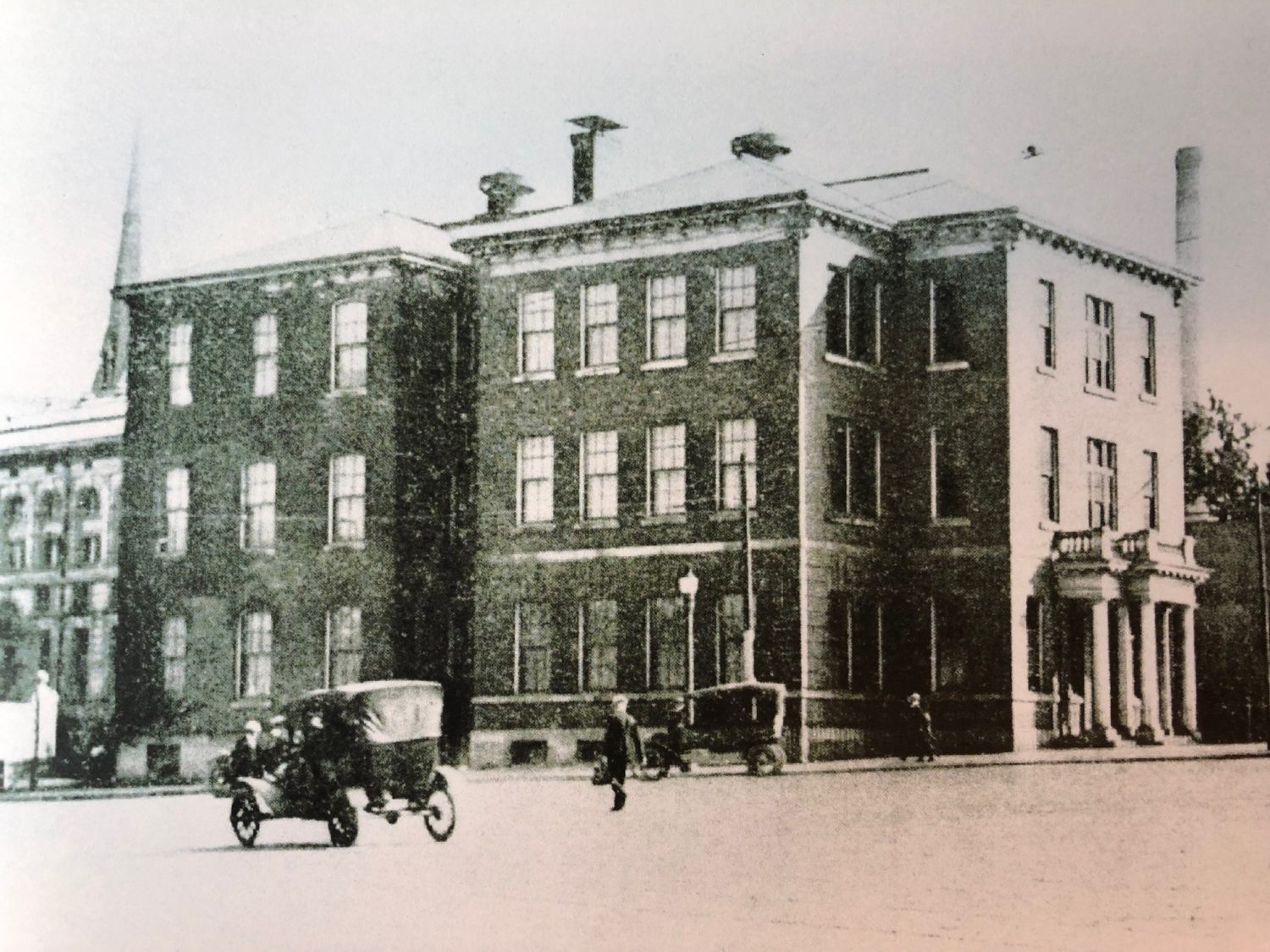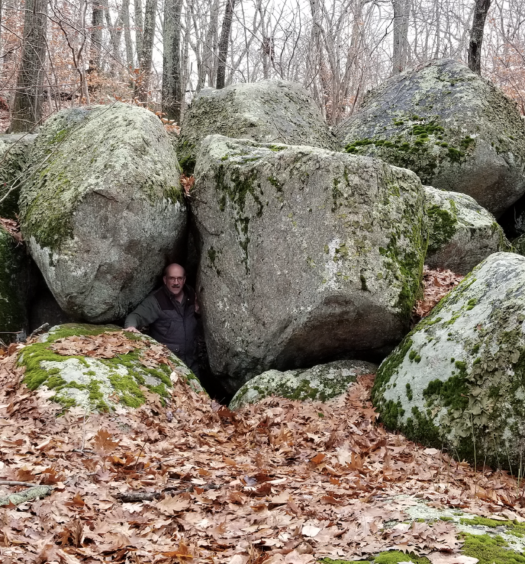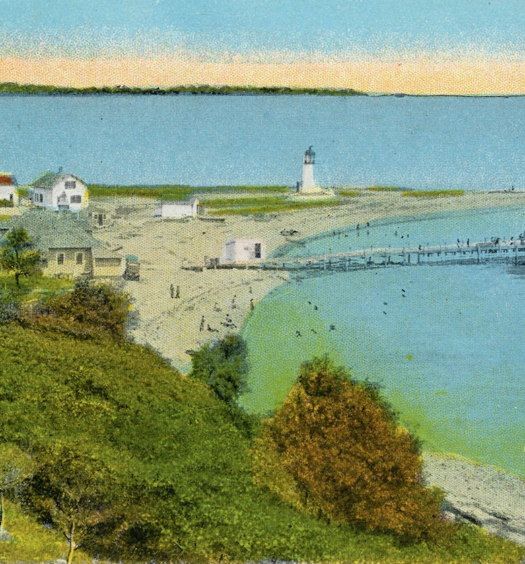LaSalle Academy, as most readers know, is a Catholic college preparatory school located in Providence. It began in 1871 as a result of discussions among Bishop Francis McFarland, Rev. Michael Tierney, rector of the Cathedral of SS. Peter and Paul, and Brother Patrick (Murphy), the American provincial of a teaching order of French origin called the Christian Brothers (F.S.C.) of St. John the Baptist de LaSalle.
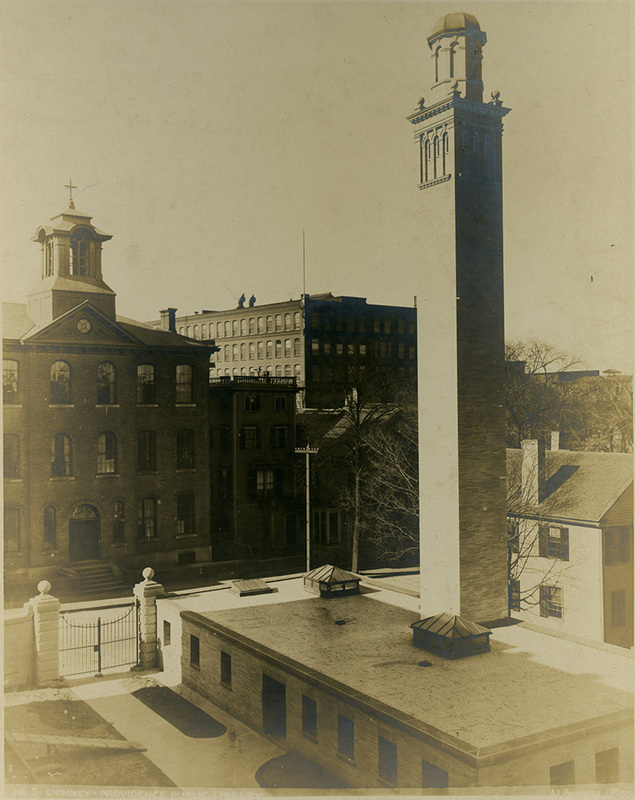
LaSalle Academy opened its first building on the corner of Fountain Street and Broadway in downtown Providence. The old chimney and stackhouse from the Providence Public Library are visible in the foreground of this photo; La Salle is the building across the street with a cross on its cupola (Providence Library Digital Collections)
In 1870, the brothers agreed to come to Providence. Their arrival, however, was delayed for one academic year. Thus, the Cathedral’s Fountain Street Academy for the instruction of the boys of Cathedral parish opened in September, 1870 under local instructors. Finally, in September 1871, at the start of the Fountain Street Academy’s second school year, three Christian Brothers arrived and took up residence in a small two-and-a-half-story frame building at 125 Fountain Street next to the parish’s three-story brick academy. They established Rhode Island’s first religious order of men with Brother Ptolemy, the school’s first director. He took the name not of a saint but of a First Century Greek astronomer and mathematician whose calculations included the theory that the planet earth was spherical rather than flat. Ironically, that concept foreshadowed the well-rounded educational experience LaSalle students would receive from the Christian Brothers.
Instruction for boys was initially conducted both on the grammar and high school levels, and the academy was basically a parish institution. Gradually, however, the “Brothers’ School,” as it was popularly called, evolved into the present LaSalle Academy. It is Bishop McFarland’s most significant legacy to the Rhode Island Catholic community prior to the division of his Diocese of Hartford in 1872 to create the diocese of Providence led by Bishop Thomas Hendricken.
LaSalle grew rapidly to educate boys well-beyond the bounds of Cathedral parish. Its expansion led to the construction of a much larger adjacent building. This three-unit school complex (replaced in 1940 by the Providence Police and Fire Bureau) gave its name to the present large intersection opposite the entrance to the Dunkin Donuts Center that we call LaSalle Square.
Because of its rapid growth, LaSalle moved to its present beautiful thirty-acre campus on the former Hazard Farm in 1925. Its site extended from Smith Street in Providence’s Elmhurst neighborhood southward into adjacent Mount Pleasant, giving Academy Avenue its name. Its present spacious, well-built campus gives the school the aura of a university– an appearance befitting its role in preparing its students for college.
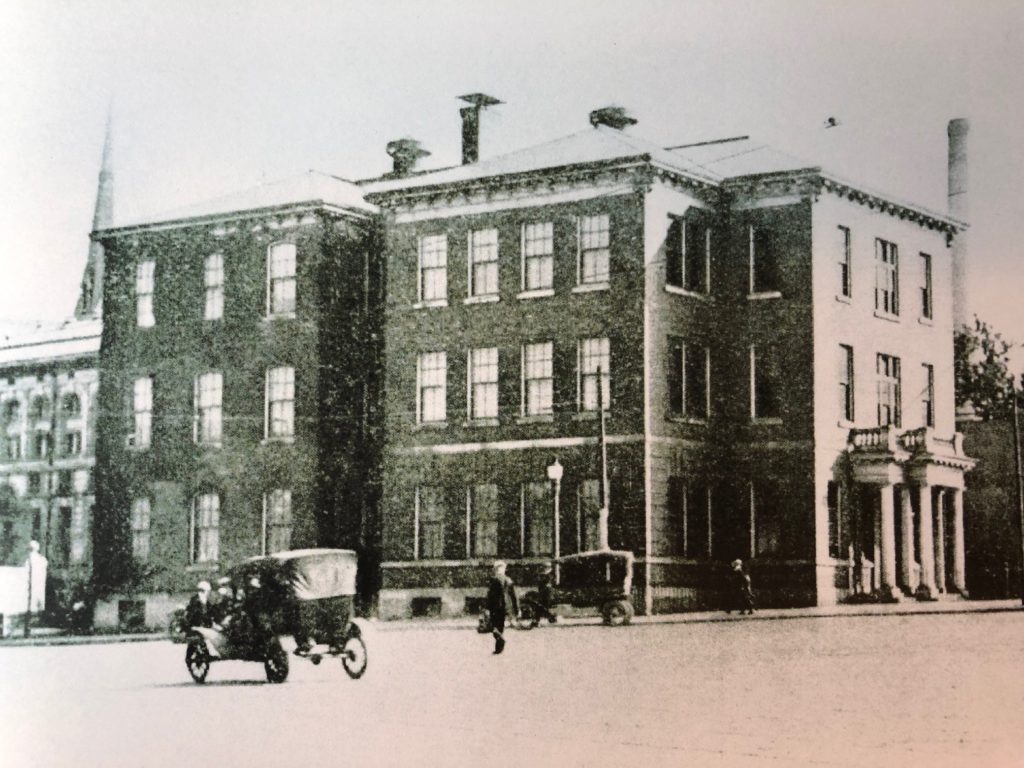
LaSalle Academy was initially called the Fountain Street Academy. An early photograph (ca. 1915) shows the school after it had expanded from the first building (immediately to the left) with the Christian Brothers’ residence (extreme left). The school complex was located near the present LaSalle Square opposite the front of the Dunkin Donuts Center.
As LaSalle physically expanded so also did the composition and hometowns of its student body. From Woonsocket, home of a Pulitzer Prize-winning novelist (Edwin O’Connor), to Westerly from which NFL star Don Panciera traveled by train to captain LaSalle’s 1945 national co-champion high school football team, LaSalle’s students came in droves to partake of the moral guidance and knowledge dispensed by the Christian Brothers and by the school’s dedicated lay teachers, who worked for pay far less than they could have earned in a public school.
From my brief stint as an instructor there (1961-1962), I can state with conviction that LaSalle’s teachers and coaches – clerical and lay – were the most dedicated that I ever encountered during my long educational career. Memorable among these lay instructors were Vincent McGinn, Thomas Lowery, Peter Curtin, and Joseph Palmer. The selfless, quasi-anonymous devotion of the array of Christian Brothers who have taught there, far from their family homes, is awe-inspiring.
The most significant event in LaSalle’s long history occurred in September, 1984, when girls became students. The decline in parish schools had reduced the flow of male students, so a much-needed merger with LaSalle of St. Patrick and St. Mary girls’ high schools in Providence not only ensured but enhanced its continued prosperity. By that union, the LaSalle board of trustees made all prior graduates of these two schools LaSalle alumnae, a gesture approved with the vigorous support of Helen Marandola, the only woman board member and a graduate of St. Mary’s Broadway.
In 1993, the school’s PEGASUS program admitted junior high school students and in 2015 LaSalle expanded further by establishing the De LaSalle Middle School program for grades 6 through 8. Of even more significance is the recruitment and inclusion of a much greater number of minority students via a generous scholarship program.
Most LaSalle graduates over the past 150 years did not achieve wealth, power, fame, or stardom, but they became informed citizens, the basis of our democracy; they became faithful parishioners, the bedrock of their church; and they became good parents who transmitted to their children the moral and ethical values taught to them by the Christian Brothers. Through these unsung graduates, the influence of LaSalle subtly has permeated Rhode Island, thereby making our state a much better place in which to live.
However, LaSalle alumni have more significantly impacted Rhode Island and the nation in many fields of endeavor– but primarily in government and politics. The school has produced five governors (J. Howard McGrath, All-State football star, Dennis J. Roberts, J. Joseph Garrahy, Edward DiPrete, and Gina Raimondo), and four U.S. Senators (Felix Hebert, J. Howard McGrath, Jack Reed, and Patrick Toomey of Pennsylvania). Presently, it is one of two high schools in America with two incumbent U.S. Senators (Reed and Toomey).
LaSalle graduates also include two congressmen (Robert O. Tiernan and Jack Reed). Tiernan, an all-state hockey player, became chairman of the Federal Elections Commission after his Congressional tenure. House Speaker, Matthew Smith, his successor Joseph DeAngelis, and most recently Nicholas Mattiello, five mayors of Providence (Joseph Gainer, John Collins, Dennis Roberts, Joseph Doorley, and Joseph Paolino) were LaSalle educated, as were mayors of several other Rhode Island cities.
Nationally, J. Howard McGrath, as national Democratic chairman, directed President Harry Truman’s 1948 upset victory and was rewarded with the positions of Solicitor General and then Attorney General of the United States. Thomas Donilon was President Barack Obama’s National Security Advisor. More recently, President Biden appointed LaSalle alumnae Gina Raimondo as his Secretary of Commerce. On the GOP side, John McLaughlin was the principal speechwriter for Presidents Nixon and Ford and later a popular TV political commentator.
In law, our judiciary is replete at every level with LaSalle graduates. One, Thomas Roberts, was chief justice of our state Supreme Court from 1966 until his death in January, 1976. The Rhode Island Bar Association has hundreds of LaSalle alumni. In addition, LaSalle graduates have entered the field of law enforcement. They have headed several local police forces, and Colonel Steven O’Donnell has commanded the Rhode Island State Police. The state’s chief law enforcement officer is the elected attorney general; LaSalle graduates J. Joseph Nugent and James O’Neil held that position. U.S. Attorneys for the District of Rhode Island who received a LaSalle education were the ubiquitous, including J. Howard McGrath, Edward McEntee, and Edward Gallogly, who also served as lieutenant governor and Chief Judge of the Family Court.
In the area of religion LaSalle seems like a minor seminary in the number of bishops, priests, lay brothers, nuns, and deacons who have studied or taught there. Notable among this numerous group are Russell J. McVinney, Bishop of Providence (1948-1971) and “Mr. Providence College,” the Rev. Joseph L. Lennon, O.P. the “TV Priest”, orator, and a prolific writer, and Bernard M. Kelly, former auxiliary bishop of the Providence Diocese, attorney, and teacher of Latin at LaSalle.
In the field of education LaSalle merits an A+. It has given Rhode Island and the region hundreds of school teachers, coaches, and school committee members, as well as municipal superintendents, college professors, and college presidents. One classroom teacher, Edward McElroy, became president of the powerful American Federation of Teachers Union.
LaSalle’s impact on the medical profession has also been great. Many doctors, dentists, nurses, researchers, hospital administrators, and other health officials got their high school education at LaSalle. Most conspicuous in this field is Dr. John O. Pastore, Jr. who was a Board Member and Secretary of the International Physicians for the Prevention of Nuclear War when the organization was awarded the Nobel Peace Prize in 1985, and Reverend Dr. Angelo D’Agostino, Jesuit medical missionary in Africa.
In business, LaSallians have also excelled with an impressive roster of CEO’s and bank presidents. Notable here is one of LaSalle’s great benefactors, Walter McLaughlin, an auto parts magnate, whose generosity to LaSalle is acknowledged by the naming of the school’s athletic center in his honor. All-State athlete John McLaughlin and John Moran, “the Budweiser Twins” were also proud alumni along with major liquor distributor Raymond Mancini, Dennis Picard, CEO of Raytheon Corporation, and John Cummings, CEO of Fleet Financial.
Some students with technical and mechanical skills elected to embark upon a career in the building trades working from the ground up in plumbing, electrical projects, carpentry, and general construction to establish their own firms. Others like Tony and Stephen Cardi, and All-State runner Anthony Marandola, dramatically expanded the family companies they inherited.
God and Country were hallmarks of the LaSalle tradition leading many alumni to pursue military careers. The list of LaSalle generals and naval officers is impressive, and its roll call of war heroes is long. Notable are Major General J. M. Devine, World War I and World War II battle commander and later Chief of Army Ground Forces; Commander John A. McIntyre, All-State and then All-American football lineman at Notre Dame, World War II and Korean War flying ace; General Philip Conley, World War II fighter pilot and commander of the first space shuttle landing; and Michael Tripp, an undefeated high school wrestling champion who became a highly decorated and well-publicized veteran of the Vietnam War.
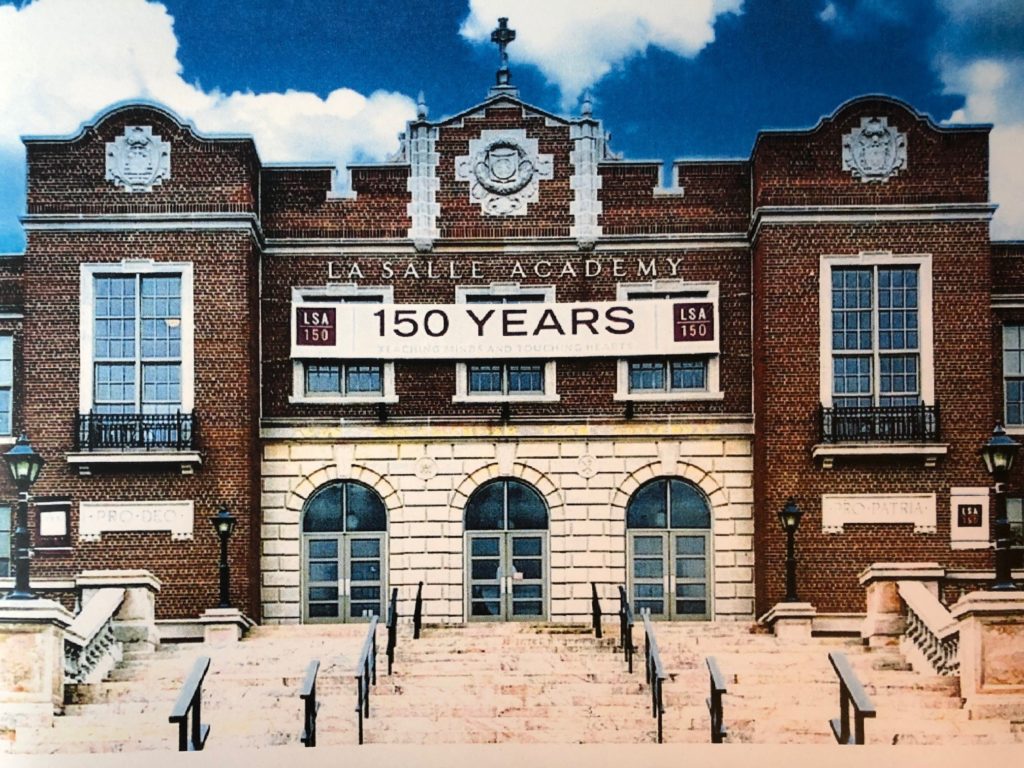
The current main building of LaSalle Academy at 612 Academy Avenue in Providence, with signs celebrating its 150th anniversary
In sports, LaSalle is the Notre Dame of Rhode Island with more team championships than any other high school. Its athletes have starred in major league baseball, the NBA, the NFL, and the NHL. Some athletes even rose to top administrative positions with professional teams such as LaSalle All-Staters James “Lou” Gorman, general manager of the Boston Red Sox, and Lou Lamoriello, CEO of the New Jersey Nets of the NBA and president and general manager of the New Jersey Devils of the NHL. Among these professional athletes, Davey Lopes in baseball and Joey Hassett in basketball compiled the most impressive career statistics and achievements. In addition, some LaSalle athletes have been members of medal-winning U.S. Olympic teams.
Some of the school’s coaches have become household names in Rhode Island such as Jack Cronin and Milt Rhenquist, stars of the 1928 NFL champion Providence Steam Rollers, Dan O’Grady, Lou Cimini, Carl Toti, Bernie Pina, and Ray Dwyer, all of whom worked with famed athletic director, Brother Antony of Jesus (Harte).
Brown University (founded in 1764) is the only educational institution with more Rhode Island Heritage Hall of Fame inductees than LaSalle Academy– a high school that accounts for over five percent of the Hall’s entire membership– with more to come. That alone is cause for celebration!

